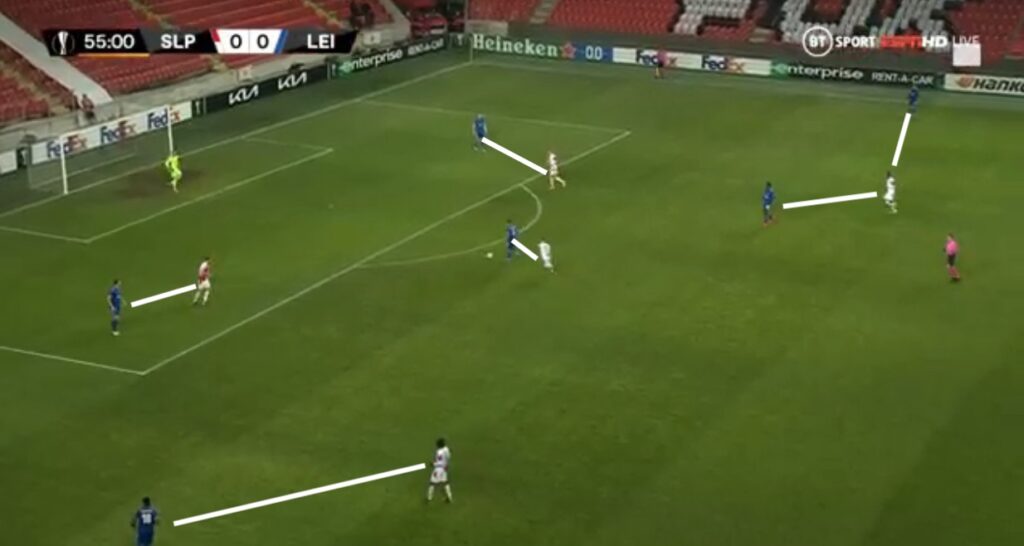The 2020/21 season is in the balance for Arsenal as the team face Slavia Prague over the next two weeks. Many probably considered the Europa League quarter-final draw favourable but Slavia are not to be taken lightly.
The Czech champions arguably shouldn’t even be in the competition after defender Ondrej Kudela was accused of racially abusing Rangers (and ex-Arsenal) midfielder Glenn Kamara in the previous round, but it shouldn’t surprise anyone to see Uefa barely acting against racism. Kudela is unlikely to play after suffering a nose injury on international duty courtesy of Gareth Bale’s forearm.
That leaves an issue in defence, where further injuries mean a midfielder is likely to move into the backline and the club’s first choice goalkeeper is unlikely to play.
@LGAmbrose Slavia coming to London with only one recognised CB. 2 injured and one not registered in EL https://t.co/8eREKdAPkI
— AnnounceMbappe (@vivastiann) April 6, 2021
Still, Slavia have been dominant in the Czech league over the past few seasons and competitive in Europe as well. It isn’t their fault, after all, that the Czech league isn’t stronger and they can’t be underestimated after proving they can compete in continental competitions. They reached this stage before losing to Chelsea in 2019, drew with Barcelona (0-0) and Inter (1-1) in their Champions League group the following season (with West Ham duo Tomas Soucek and Vladimir Coufal), then beat Bayer Leverkusen (1-0) and Nice (3-2, 3-1) in this season’s group stage before knocking out Leicester (2-0 on aggregate) and Rangers (3-1 on aggregate) to meet Arsenal in the quarter-finals.
Ahead of the quarter-finals, I watched both legs against Leicester to try and get an idea of how Slavia might approach this one.
They lined up in a flexible 4-1-4-1 against Brendan Rodgers’ side with strict man-marking in midfield, and we can expect something similar given Arsenal will line up with someone (almost definitely Martin Odegaard) in the number 10 role.
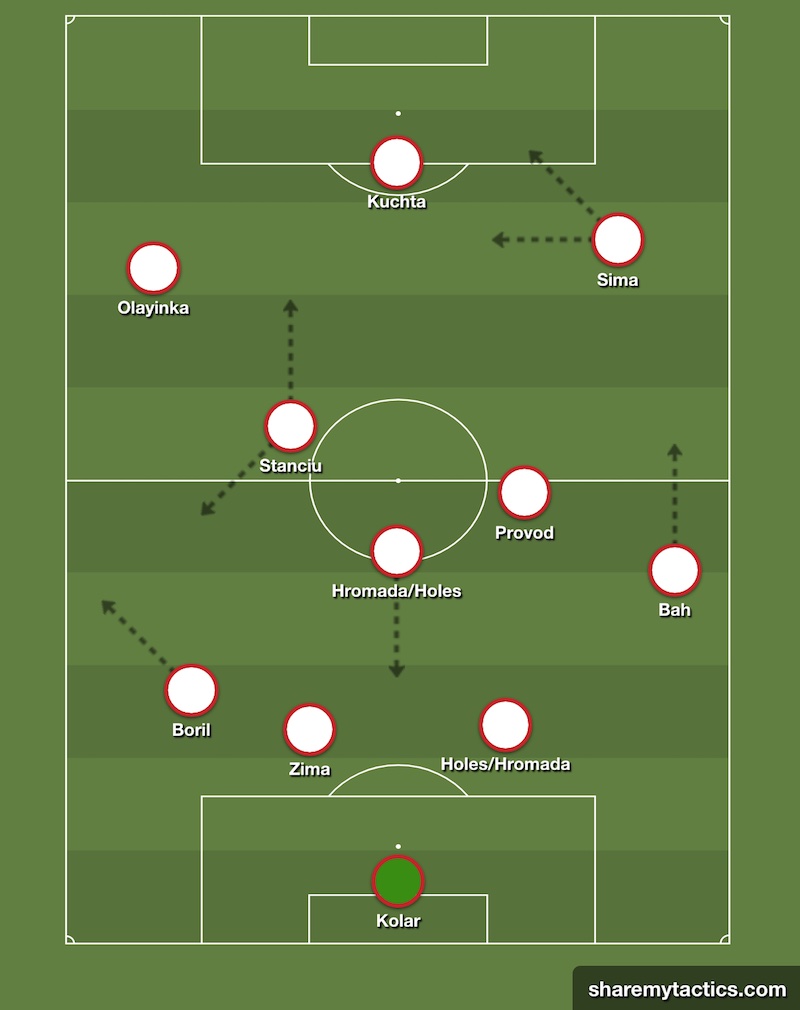 How Slavia defend
How Slavia defend
Press build up and look to win the ball high upfield. This is supposedly how they play in the Czech league and they aren’t willing to bend against bigger opposition. Leicester are third in the PL but they weren’t intimidated and looked to play on the front foot, so we can expect the same.
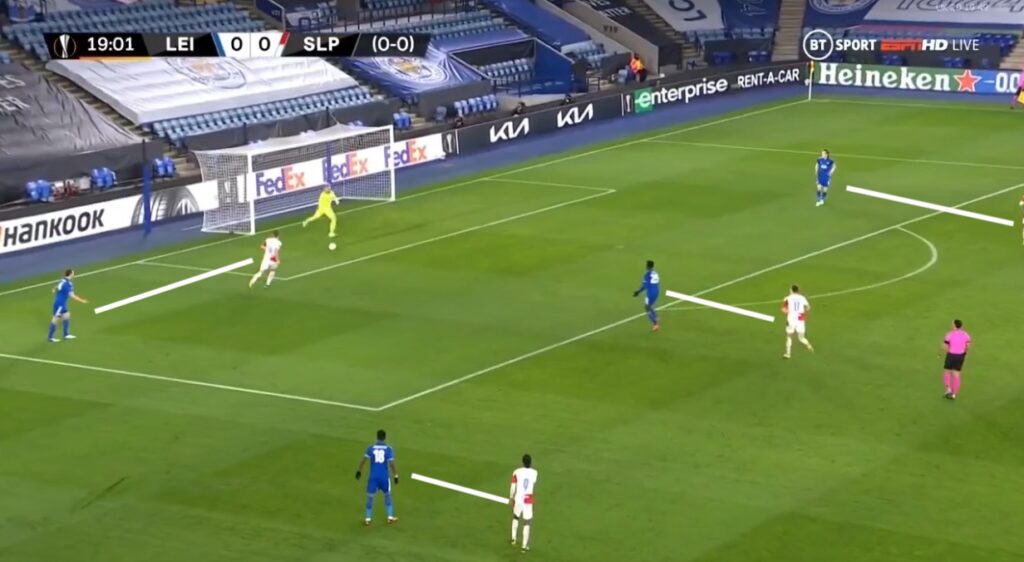
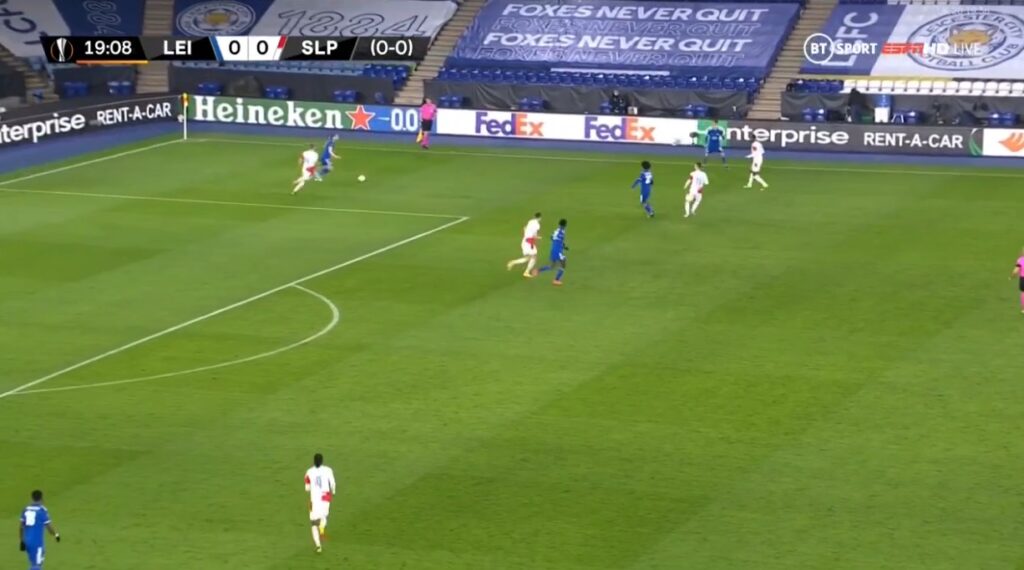 Leicester completed just 307 passes in the away leg, their fewest in an EL game this season and less than in 63 of their 68 Premier League matches since the start of last season.
Leicester completed just 307 passes in the away leg, their fewest in an EL game this season and less than in 63 of their 68 Premier League matches since the start of last season.
This wasn’t because Slavia put lots of pressure on the ball, but pressure on players who could potentially receive possession from a team-mate. An extreme man-marking approach in midfield saw Leicester struggle to find passing options, with Slavia having their three-man midfield mirror Leicester’s throughout the opening leg.
Leicester started in a 4-2-3-1, so Slavia’s two more advanced central midfielders picked up their opposite men. More interesting, and instructive to how extreme the approach was, was to see how closely James Maddison was tracked no matter where he went.
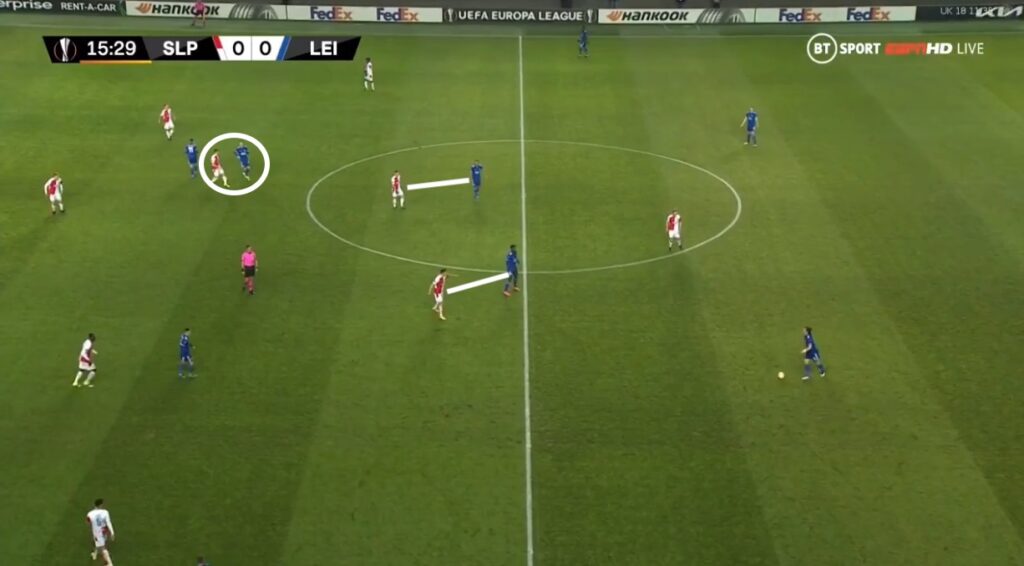 Just look at how deep Maddison (Leicester’s number 10) has come for the ball below and been followed by his marker.
Just look at how deep Maddison (Leicester’s number 10) has come for the ball below and been followed by his marker.
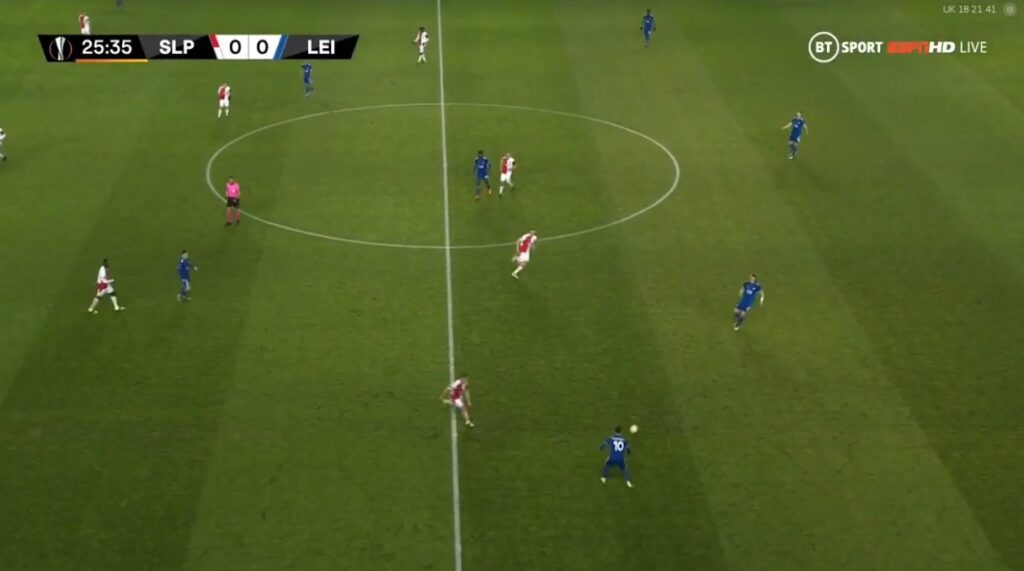 Who then follows him back upfield to once again be the deepest midfielder seconds later.
Who then follows him back upfield to once again be the deepest midfielder seconds later.
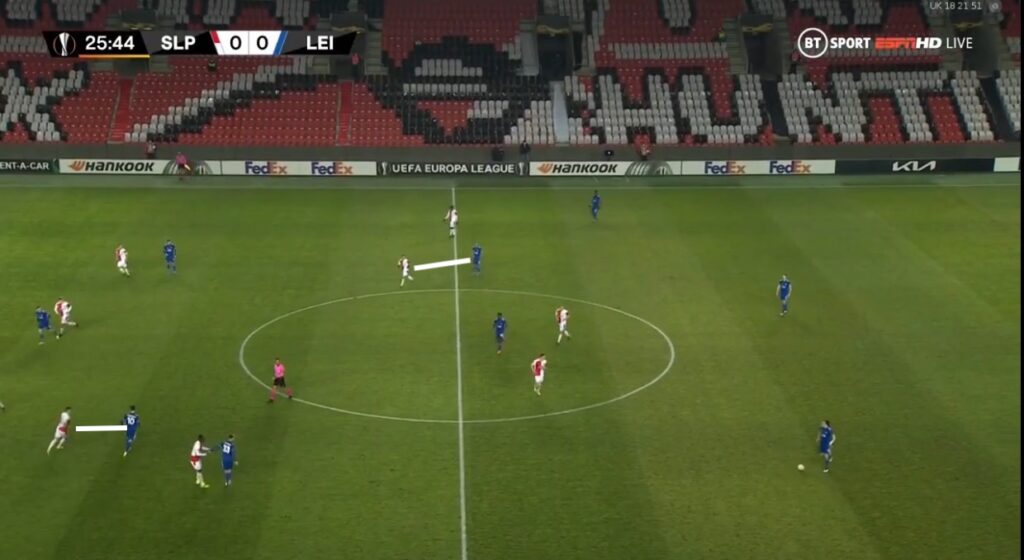 The approach is similar to how Leeds defend and Arsenal moved the Yorkshire outfit around well with smart and flexible movement in the not-too-distant past.
The approach is similar to how Leeds defend and Arsenal moved the Yorkshire outfit around well with smart and flexible movement in the not-too-distant past.
Something Leicester didn’t use enough in the first leg was movement from Maddison away from the centre of the park, dragging his marker with him and leaving space for one of the deeper midfielders to collect possession between the lines if and their marker left them to join an attempt to press higher upfield.
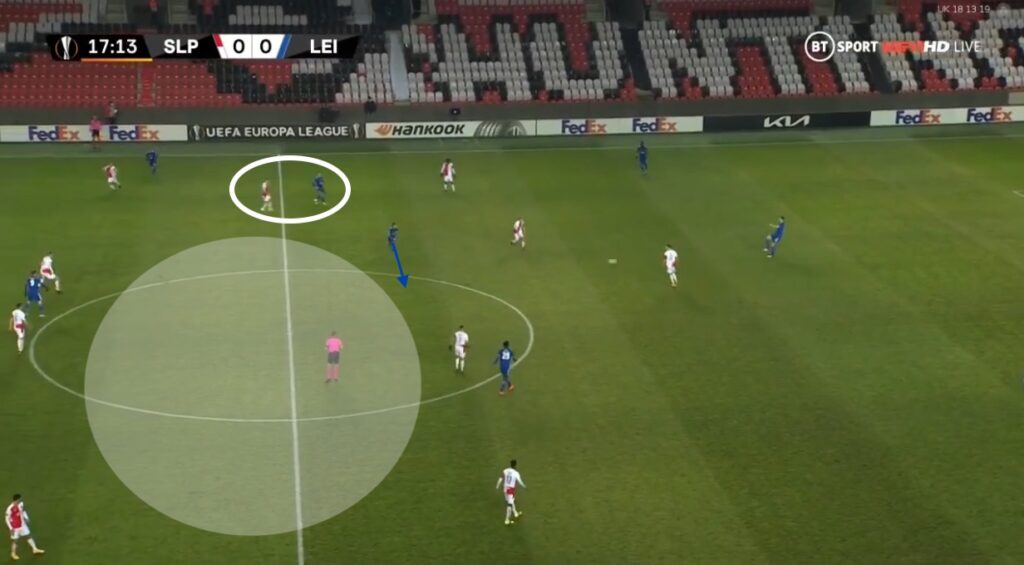 The centre-backs should have plenty of time to pick passes behind the lines and even drive into those spaces. The midfield marking is so man-oriented, that one of Arsenal’s centre-backs should almost always be spare and have the time and space to drive forward.
The centre-backs should have plenty of time to pick passes behind the lines and even drive into those spaces. The midfield marking is so man-oriented, that one of Arsenal’s centre-backs should almost always be spare and have the time and space to drive forward.



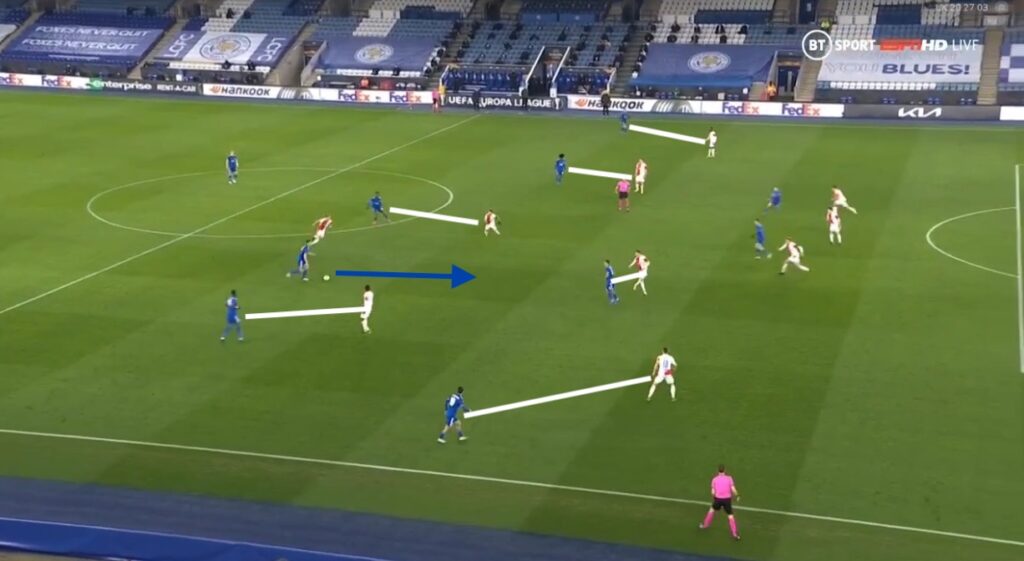 There should often be a spare man in defence and they will have the space and time to drive and look for more incisive passes. This would’ve been ideal for David Luiz but Gabriel can also do the job and will have to take on that responsibility if he plays.
There should often be a spare man in defence and they will have the space and time to drive and look for more incisive passes. This would’ve been ideal for David Luiz but Gabriel can also do the job and will have to take on that responsibility if he plays.
Another thing that can be effective against this approach is sharp movement on the flanks. In the examples below the Leicester left midfielder (circled) comes central, dragging the Slavia right-back forward and inside, giving space for the left-back to overlap into.
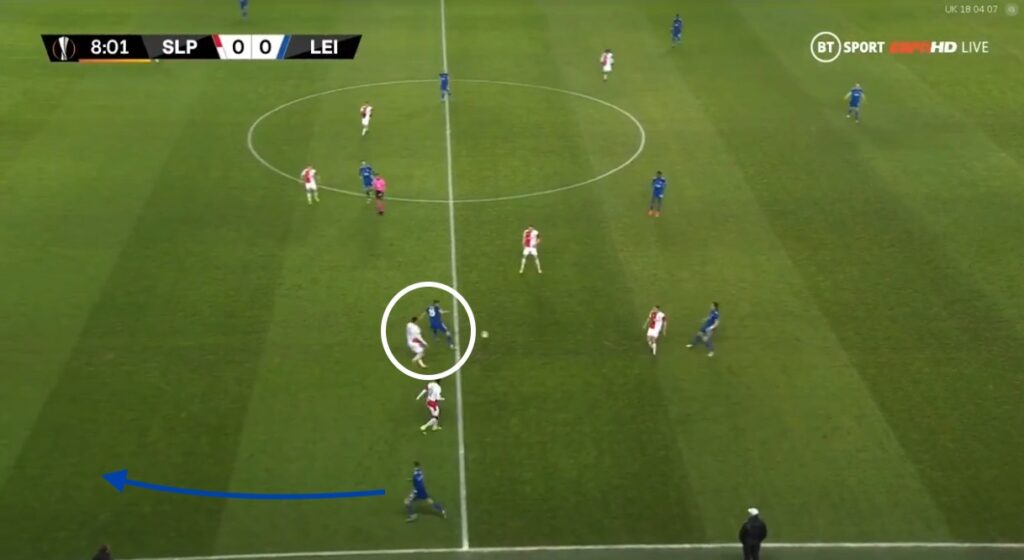
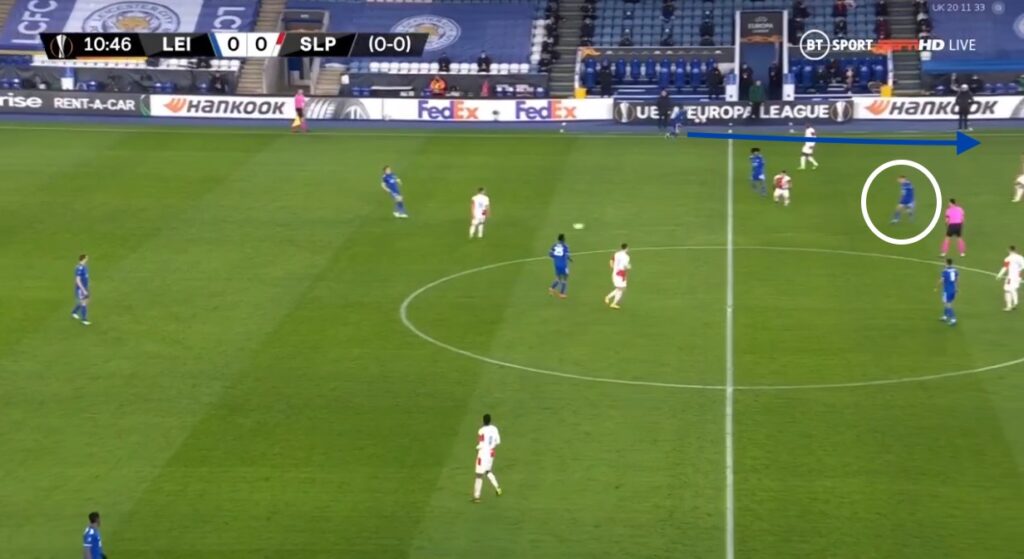 Obviously this would have been ideal for the way Arsenal use Bukayo Saka or Emile Smith Rowe ahead of Kieran Tierney, who will miss out through injury, but the pattern should still be exploited regardless and can be used on the other flank too.
Obviously this would have been ideal for the way Arsenal use Bukayo Saka or Emile Smith Rowe ahead of Kieran Tierney, who will miss out through injury, but the pattern should still be exploited regardless and can be used on the other flank too.
How Slavia attack
They’re happy to either build up or go longer and the variance in their play makes them hard to predict. Players are constantly seen making runs beyond the backline to drag their markers with them and create spaces for shorter passes. Left-winger Olayinka is a willing runner in particular, threatening behind the right-back often as well as drifting further infield.
 They often look to build up on the left of the pitch, looking to attract as many players as possible to that side before switching to the right, where 19-year-old Abdallah Sima and January signing Bah are direct.
They often look to build up on the left of the pitch, looking to attract as many players as possible to that side before switching to the right, where 19-year-old Abdallah Sima and January signing Bah are direct.
Sima, who has 19 goals in all competitions in his first season at professional level, is their biggest threat.
Sima tries to move in behind when the striker drops off and caused Leicester some issues with his runs in behind. As target man Jan Kuchta (circled in the images below) drops off and attracts a centre-back, Sima makes his move inside and Stanciu, the team’s most technically gifted and creative midfielder, is always looking to release him as quickly as possible.
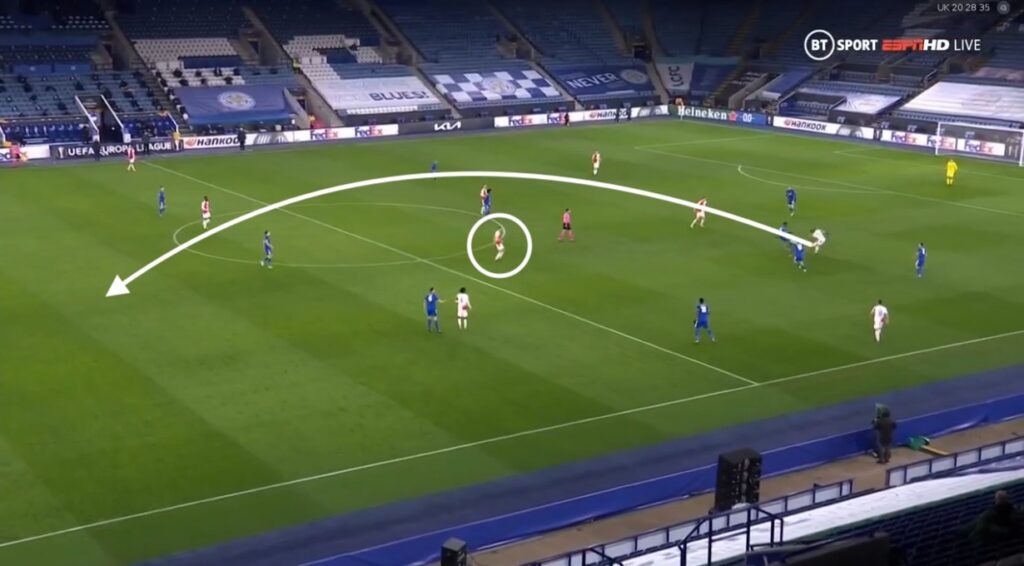
 If Sima gets the ball, he’s a goal threat, if he doesn’t, or not where he can run onto it, he drags the opposition left-back across and leaves space for the aggressively positioned Bah to drive into.
If Sima gets the ball, he’s a goal threat, if he doesn’t, or not where he can run onto it, he drags the opposition left-back across and leaves space for the aggressively positioned Bah to drive into.
The right-back looks a good player and a real threat from defence. Signed from a midtable Danish club in January, he serves as a reminder that you don’t need to focus exclusively on established players, that bargains are out there, while bargains are out there to be found to contribute in squad roles.
As for how Slavia use him, look how many players they gather on the left flank, the side they seem happier to build up on, while Sima essentially positions himself as a striker to give Bah as much space as possible.
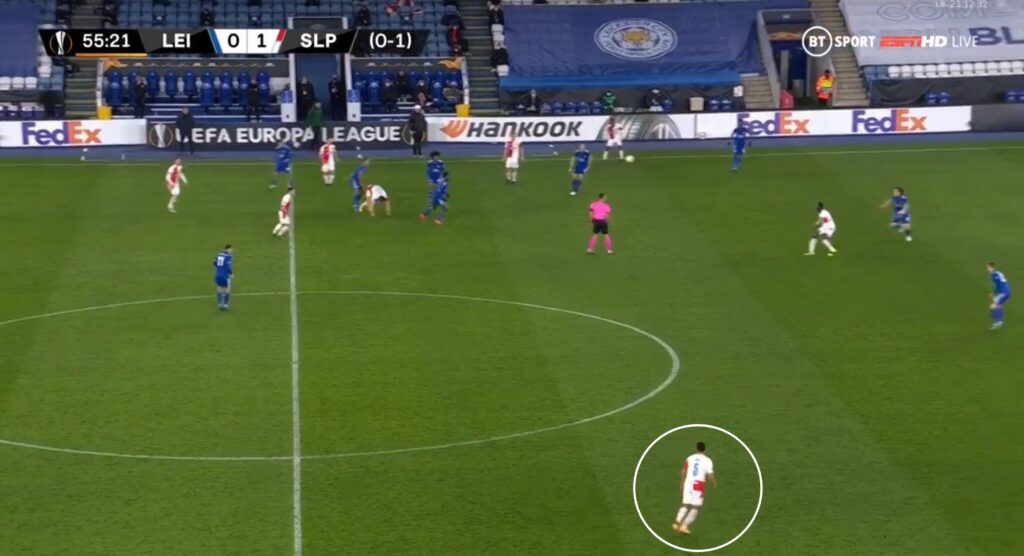
 Whoever Arteta plays on the left will have to be wary of their duty to track back an attack-minded right-back.
Whoever Arteta plays on the left will have to be wary of their duty to track back an attack-minded right-back.
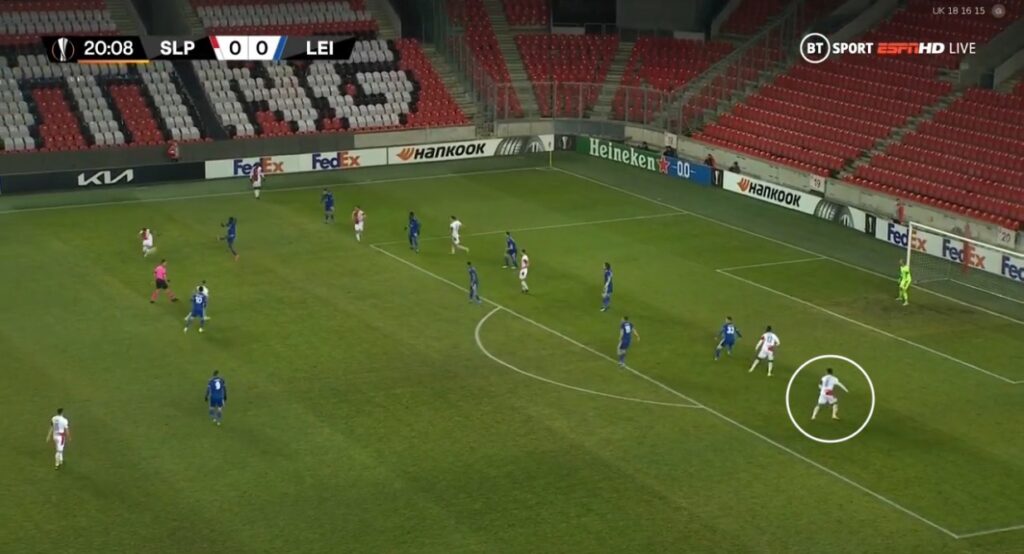 Even though they are attack-minded, Slavia take precautions at the same time. Even when they go forward with numbers ahead of the ball and in the box, they secure the area to protect themselves against counter-attacks.
Even though they are attack-minded, Slavia take precautions at the same time. Even when they go forward with numbers ahead of the ball and in the box, they secure the area to protect themselves against counter-attacks.
A wall of three or four players is almost always present to press any loose ball or clearance, while one player man-marks the opposition’s first outlet (circled) and they leave just a couple of outfield players back on the halfway line in case the ball does break free.
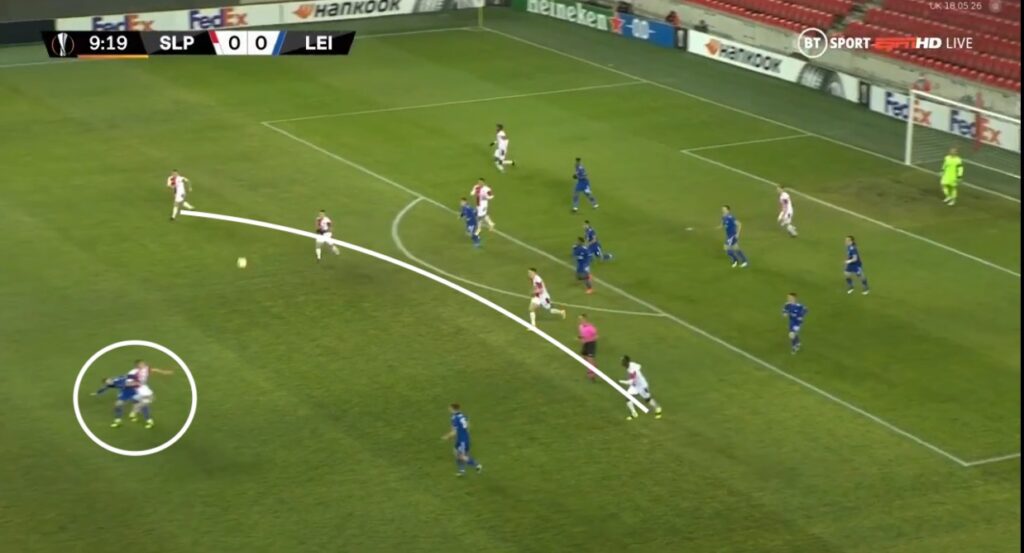

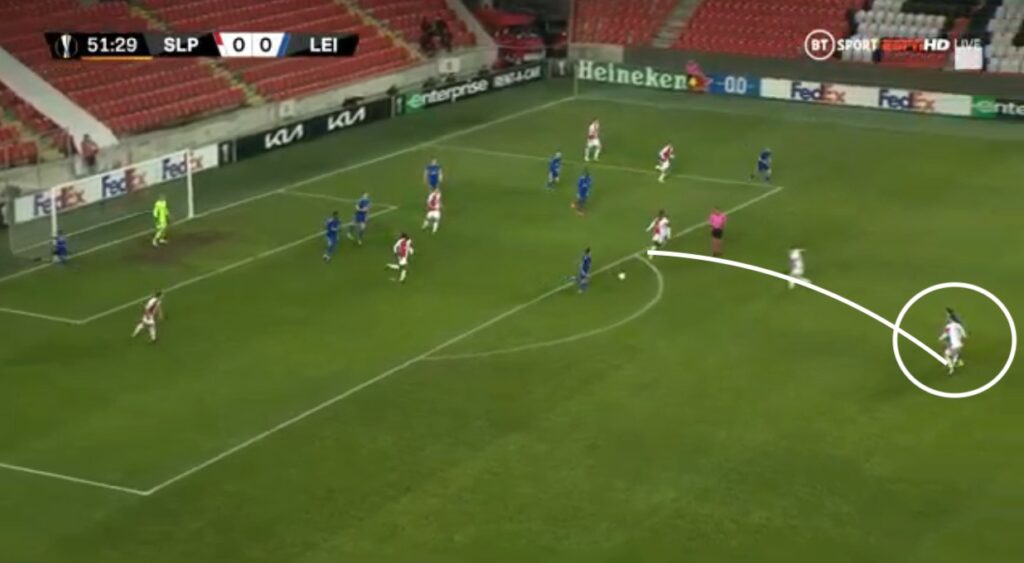 It’s a smart, effective, and well-executed way to both box teams in at and guard against breaks.
It’s a smart, effective, and well-executed way to both box teams in at and guard against breaks.
They use a similar tactic at times when forced to go long from the back, with the two deepest midfielders closing down a long ball over their heads to win the second ball.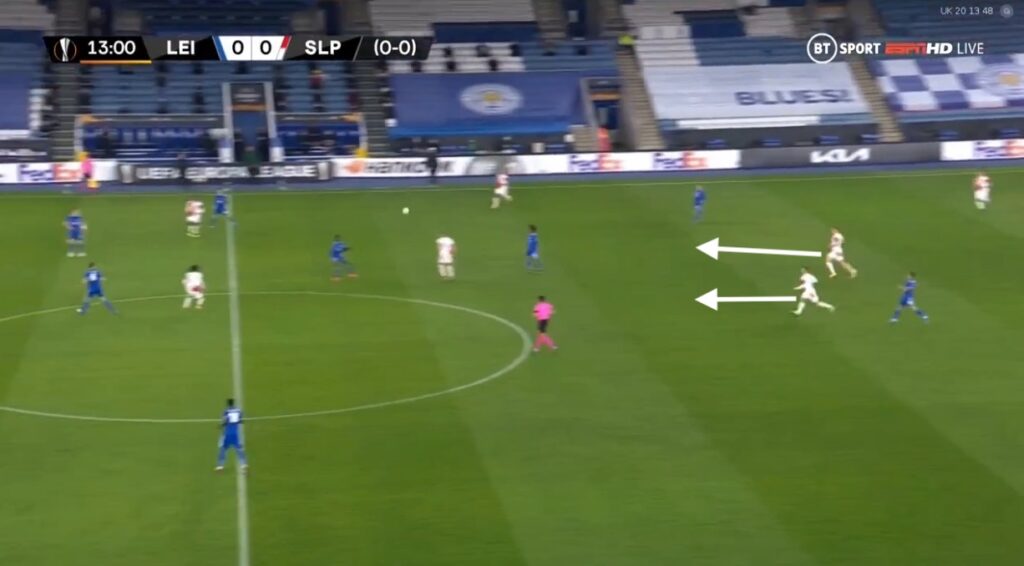 And that sort of aggression immediately after a turnover was still present after they’d taken the lead against Leicester. They win the ball back quickly after losing it in the Leicester half, with four players putting pressure on the ball as Leicester look to break.
And that sort of aggression immediately after a turnover was still present after they’d taken the lead against Leicester. They win the ball back quickly after losing it in the Leicester half, with four players putting pressure on the ball as Leicester look to break.
 This isn’t a side that will look to sit back at any point.
This isn’t a side that will look to sit back at any point.
Set pieces
Arsenal will have to be alert when the ball goes out of play and fans will no doubt remember that set pieces cost the team when they met Olympiacos last season.
Things have improved this term — no Premier League team has conceded fewer from set-pieces, as per The Athletic — and Slavia’s approach from corners was relatively predictable against Leicester, with the team tending to make runs to overload the front post in the hope of isolating a player at the back post.
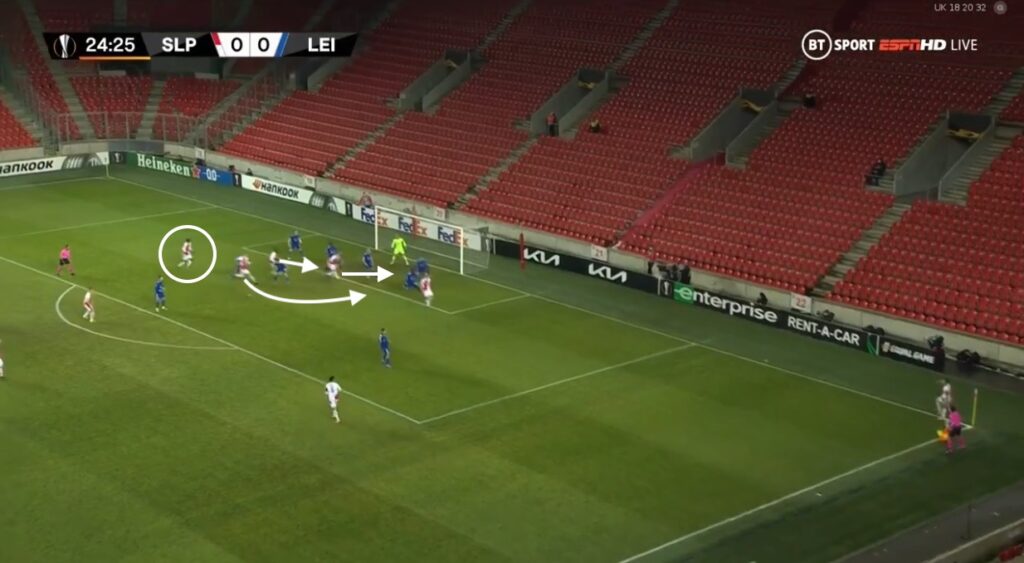

 Something else to look out for is long-ish throws from just inside our half. After overloading the wing with options, Slavia occasionally caused Leicester trouble by then throwing the ball inside and either flicking it on or getting it under control to switch play quickly.
Something else to look out for is long-ish throws from just inside our half. After overloading the wing with options, Slavia occasionally caused Leicester trouble by then throwing the ball inside and either flicking it on or getting it under control to switch play quickly.
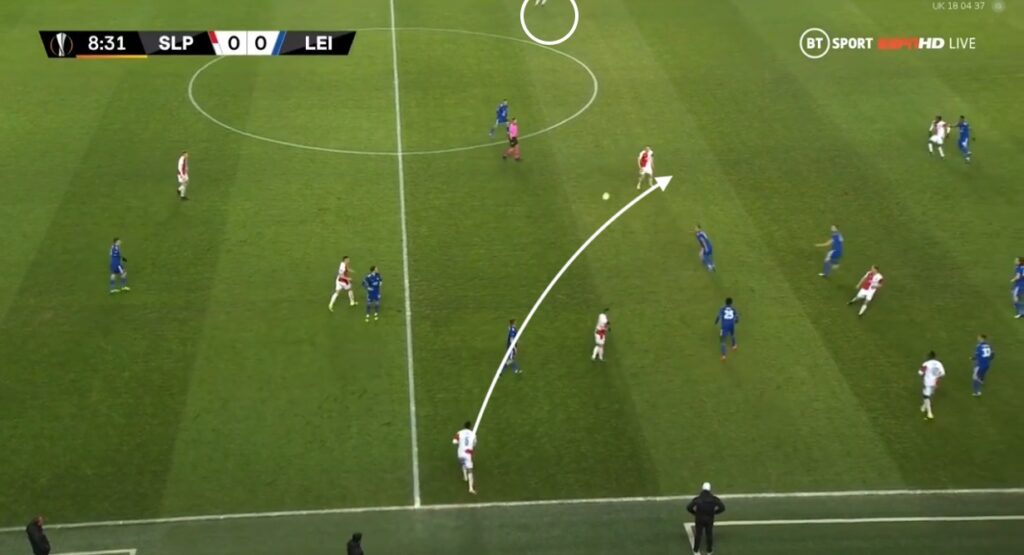
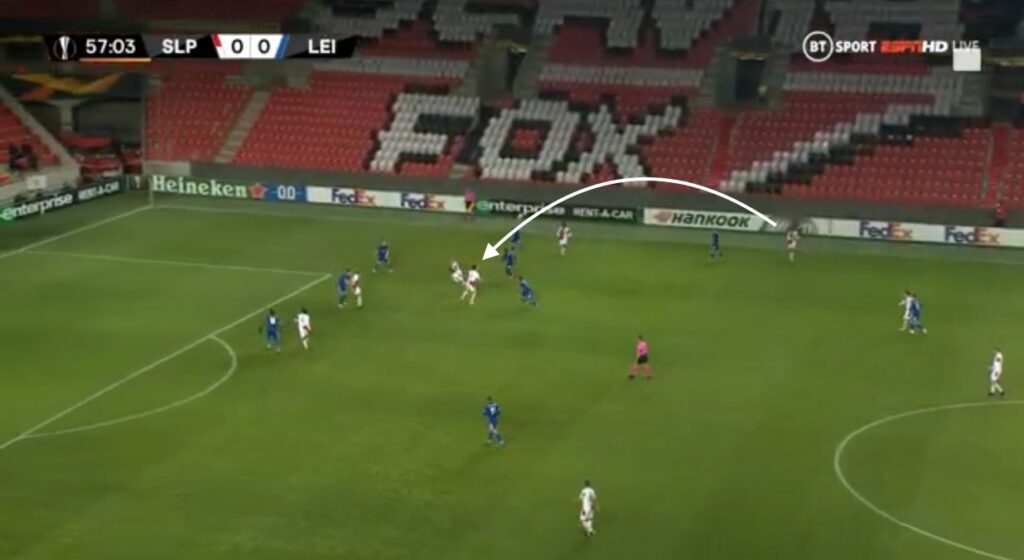 In the second leg this didn’t really work and one slightly misthrown effort allowed Leicester a chance to snatch possession and break forward.
In the second leg this didn’t really work and one slightly misthrown effort allowed Leicester a chance to snatch possession and break forward.
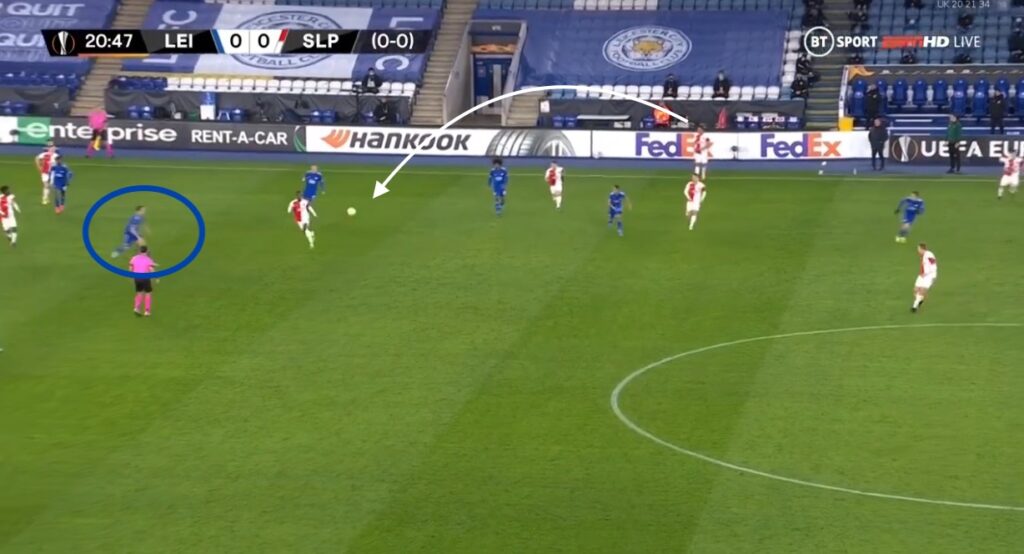 There’s plenty to admire about the way Slavia play in all phases of the game. Czech league or not, you don’t enjoy the record they’ve had over the past few years without a lot going right. Their recruitment is clearly intelligent and the coaching is excellent. Slavia have punched above their weight when underdogs in Europe and dominated domestically at the same time for a few seasons now.
There’s plenty to admire about the way Slavia play in all phases of the game. Czech league or not, you don’t enjoy the record they’ve had over the past few years without a lot going right. Their recruitment is clearly intelligent and the coaching is excellent. Slavia have punched above their weight when underdogs in Europe and dominated domestically at the same time for a few seasons now.
But this is still Arsenal we are talking about. Slavia are a good side and will be uncomfortable to play against but Mikel Arteta’s side head into this one as big favourites. They’ll have to work for it but, given the talent at Mikel Arteta’s disposal, anything but progression remains unacceptable.

